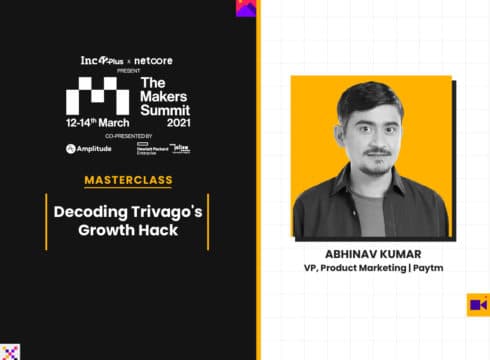Marketing amasses a lot of data but measuring the right aspects is key
The strategy was to make ‘Trivago’ a synonym for hotels and the company built on that intent. They branded their product as the answer to everybody’s hotel hunt
A believer of testing before scaling, Trivago churned out three online ad versions with three different unknown faces
Inc42 Daily Brief
Stay Ahead With Daily News & Analysis on India’s Tech & Startup Economy
The ad that got everybody talking about Trivago and its less-than-famous brand ambassador. It was an unknown face at the time, but Abhinav Kumar is now one of the most talked-about ad personalities for his turn as the Trivago man. And even now after the former India development head of Trivago has actually moved on from his role to join Paytm as a product marketing VP, Kumar is still asked about his time at the hotel booking platform.
So naturally, his session of ‘Decoding Trivago’s Growth Hack’ at The Makers Summit 2021 saw thousands of product leaders and marketers eagerly waiting for insights and anecdotes.
Sharing Trivago’s journey to success in India and its philosophy of ‘testing, understanding and scaling’, Kumar’s masterclass gave deep insights into the company’s workings and culture. Here are the key takeaways:
Testing the Product Strategy
Following the success of the ad campaign, there were more product lessons for Kumar and Trivago. One of the most requested features was a calling button for bargaining. In a country like India where negotiations are a part and parcel of every purchase, Trivago said it received suggestions to add a ‘call’ button from its vendors, which would allow people to call up and negotiate the price with hotels directly.
But after enabling the phone line feature, Kumar said that the data from the tests proved that very few users clicked on the button. Testing made Trivago realise that the notion of Indian users calling up for negotiations before the booking was a fallacy.
Similarly, another test was around product pricing, where Trivago tested how many pricing alternatives would people need to make a decision. The results proved that too many options confused the users and they bounced off Trivago and moved on to another travel platform when given more than three to four options.
Why Testing Matters In Marketing
“No decision will be taken based on how somebody thinks or feels instead it has to be backed by data.”
As an activity, marketing unearths a lot of data about the customers and the market, but measuring the right metrics or data is key. Dissecting the traditional and digital marketing segments, Kumar said that it has become convenient to get feedback and two-way communication thanks to digital marketing. Even ROI can be measured easily, which was difficult in traditional marketing. So a marketer’s key role is to collate the data that actually impacts the growth of the product and its success.
For Kumar, A/B testing the marketing campaigns before making them live is critical. If product testing has to scale up, ample traffic needs to come in to view the product. So trying out different combinations and experimenting with elements is vital if product marketers are to discover the best performing strategy.
With multiple tests, product leaders get an idea of the conversion rates and bounce rates. It also allows room for creativity with content and visuals. These changes can increase user engagement, visits or product conversion depending on the test, but the crucial part is to keep fresh ideas coming.
Measure The Sentiment And Don’t Just Mull Over It
Without press releases or loud declaration of a launch, Trivago ‘soft launched’ its website in India. It brought in the initial volume of traffic via search engine optimisation, while product testing was ongoing when the marketing campaign had not yet been solidified.
One thing the product and marketing team realised was that India had the potential for huge traffic of domestic and international travelers, which made testing easier. With numerous local travel companies, the domestic competition was also quite fierce. Hence, to enter the market, Trivago strategised and portrayed itself as just a price comparison website, where hotel booking was an additional feature.
Tapping The Needs Of The Market
The need for bargains is high among Indian consumers. With Trivago’s prime element being price comparison among different hotels, Kumar said that this was the most apt product for India. The goal was to attract new-to-the-internet users, who wanted to explore hotel prices.
However, the overarching strategy was to make ‘Trivago’ as a brand synonymous with hotels. This is why it shied away from using celebrities that often overpower the brand message. The idea was to keep the focus on the product and educate the audience about its convenient usability.
Kumar recalled the launch of the Trivago campaign featuring him and said that it built a curiosity among consumers, prompting them to visit the site soon after the ad ended. While many viewers mocked and ridiculed the ad for featuring an unknown face, they also visited Trivago’s website. For the company, this was the end result that mattered and not the sentiment analysis that often accompanies ads such as these. He added that Trivago’s travel partners also acknowledged the high number of new users coming through from Trivago.
{{#name}}{{name}}{{/name}}{{^name}}-{{/name}}
{{#description}}{{description}}...{{/description}}{{^description}}-{{/description}}
Note: We at Inc42 take our ethics very seriously. More information about it can be found here.


